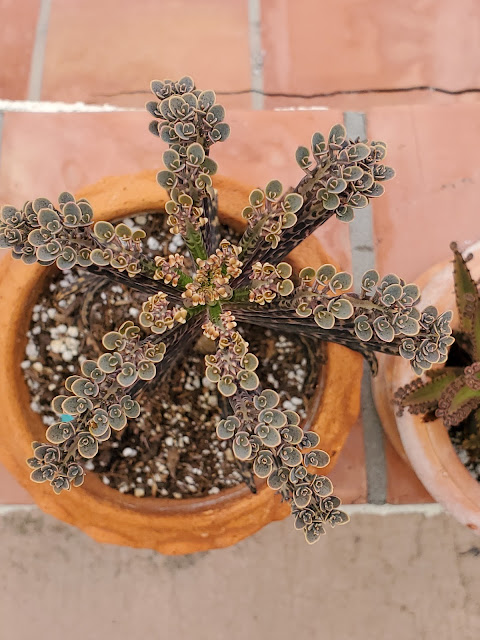I started collecting the Kalanchoes because I'd had a Mother of Thousands as a kid. Once I started looking for them as an adult, I realized that commercial nurseries don't always know which Kalanchoe species they are selling. There is apparently a lot of confusion over which of the stalky, leggy, classical Kalanchoes are which.
Mother of Thousands is often said to be K. diagremontiana and you'll see it pictured as having broad, pale green leaves, for example here. As far as I know, that appearance is more typical of K. laetivirens, which means "green all over." Laetivirens is a hybrid of K. diagremontiana and K. laxiflora.
I have another plant said to be K. diagremontiana which is most likely a different hybrid, Kalanchoe x houghtonii, which I wrote about earlier.
Pictured below, my most-probably x laetivirens.
As you can see, the Mother of Thousands lives up to its name. It has literally dozens of plantlets growing along every mature leaf margin. These either fall off and root or, in my case, come off when I touch them to feel the irresistible detaching motion as they separate. (I've likened it to shelling peas in terms of tactile satisfaction.) The mother plant makes so many of these that they can become a nuisance or even invasive. Best to keep them in pots and remove leaf debris before they root.
Mothers of Thousands look lovely at this age, but after a year or so, they become large and leggy. They don't regrow well if you cut them (at least mine didn't) but you can uproot them or cut them off at soil level, and believe me they'll have sufficient babies underneath to fill the area. It's not like you have to buy any new ones!
Mother of Millions is another species. Mine was sold as K. tubiflora but it can also be seen on sale as
K. delagoensis. It's also often known as a Chandelier Plant. It's a classic Kalanchoe shape, a thick weedy stalk with beautiful leaves. In this case, the leaves are almost cylindrical with a furrow along the top, and a spray of plantlets at the very tip of the mature leaves. I think in a cage match between Mother of Thousands and Mother of Millions, Thousands would win in the number-of-plantlets competition. However, it's MoM that is designated as an invasive species - the plantlets escape and are hard to eradicate from your landscape.
K. tubiflora is another one which will get tall and leggy. It's too small for six months, just right for three months and then a weed for the rest of its lifecycle.
However, there's no doubt it's beautiful when seen from above. (Which is why it's pictured that way in for sale ads.)
One of my favorite Kalanchoes is Pink Butterflies. When I first started collecting these plants it seemed so rare and exotic. I eventually found one from a Chinese seller and weeks later obtained one through the post, thoroughly chemically treated before it had been allowed in the country. In its many days on a boat and trapped in customs, it had wilted to a sad stalk with a few collapsed leaves at the top and a dozen dried curls where the older leaves had been.
But as I've said before, Kalanchoes are just sproinging with growth tissues. I put it in water for a few days then planted it and got a perfectly good Pink Butterflies out of it. Because it had lost lower leaves it was a bit stalky, so when I found a domestic seller, I bought three more. They rooted perfectly as well. In a few months the "Pink Butterflies" appeared - rows of pink plantlets along the margins of the leaves, lending the plant an eye-catching fringe.
Unlike with Mother of Millions and Mother of Thousands, the plantlets don't have chlorophyll (or they'd be green). They fall off in the same quantities, but very few of them root and generate enough chlorophyll to start growing. My original four turned into about eight or nine, all of which are slower growing than their parents. I'm fine with that. As I have said, the "classic" Kalanchoe look can turn into a tall, bolted weed surmounted with unimpressive flowers, so the little ones are fine by me.
Pink Butterflies are also hybrids - Kalanchoe delagoensis x daigremontiana, our old friends.




No comments:
Post a Comment